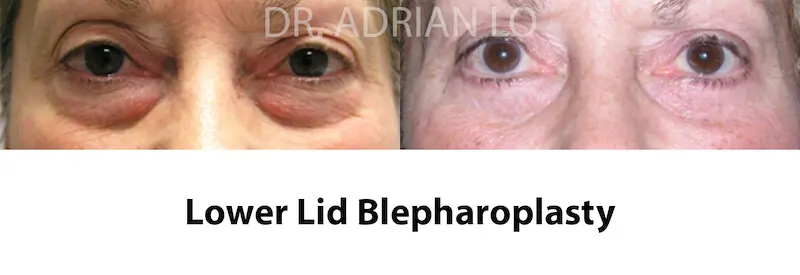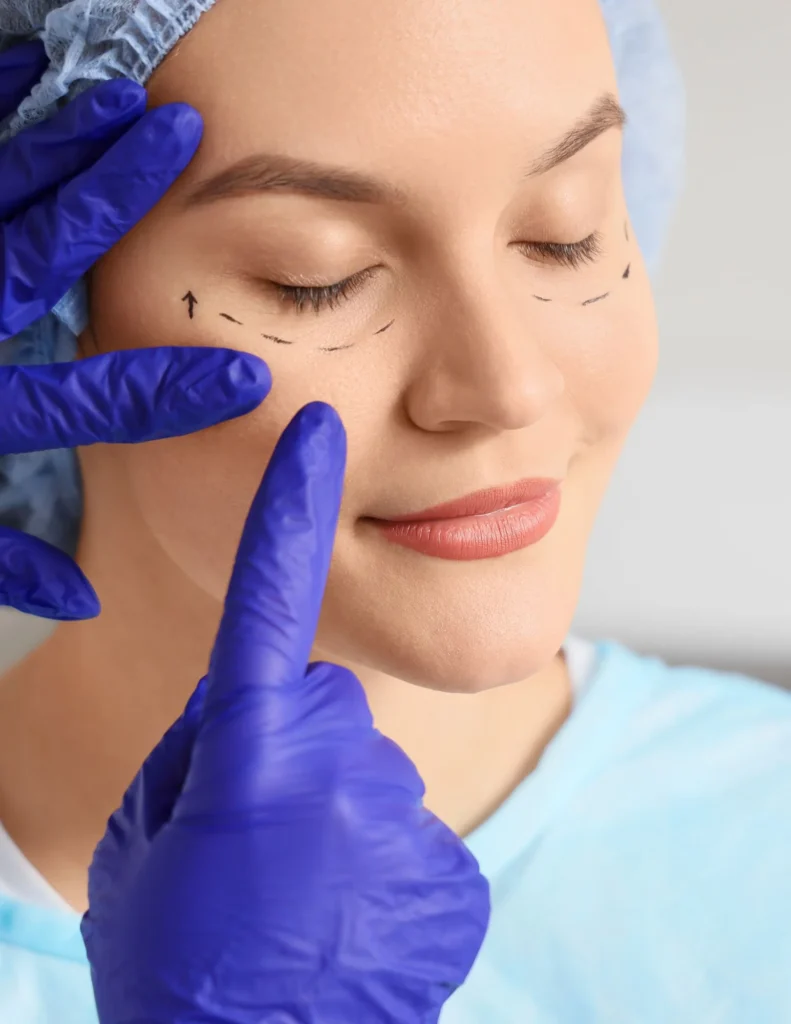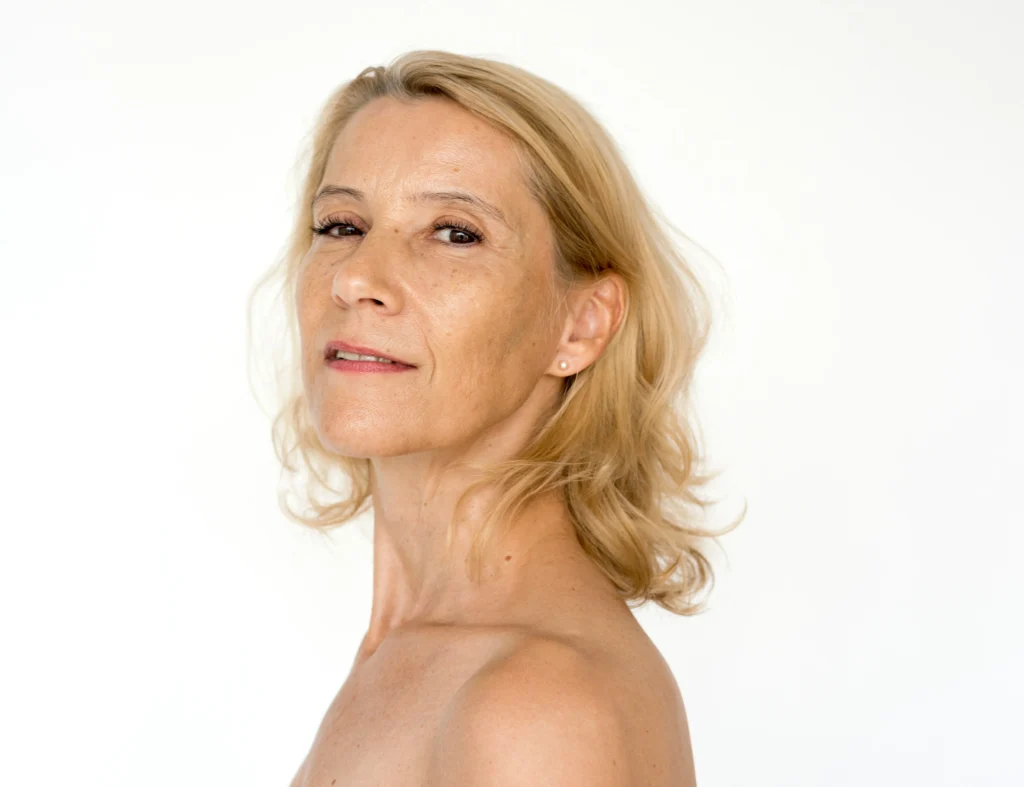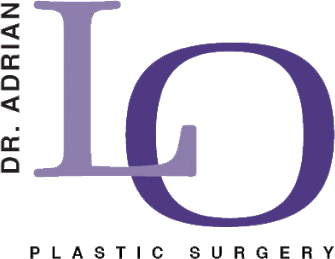The moment your lower eyelid surgery or blepharoplasty concludes, your journey toward dramatically refreshed eyes truly begins. Every day of your lower eyelid surgery recovery brings you closer to the youthful, confident appearance you desire.
Knowing what to expect after lower eyelid surgery transforms recovery from uncertainty into an empowering experience. Your healing success depends entirely on following proven recovery strategies that ensure both comfort and optimal results. The weeks ahead hold the promise of renewed confidence as you watch tired, aged eyes transform into bright, rejuvenated features that reflect how vibrant you feel inside.
This comprehensive guide reveals the insider knowledge that separates smooth, comfortable recoveries from challenging ones. You will discover professional techniques for minimizing discomfort, accelerating healing, and protecting your investment in a more youthful appearance.
Related: Lower Blepharoplasty: Before and After
What to Expect During Lower Eyelid Surgery Recovery Time
First 24 to 48 Hours After Surgery

The initial hours after lower eyelid surgery represent the foundation of your lower eyelid surgery recovery time. You will experience moderate swelling and bruising around both eyes, which signals that your body has begun the natural healing process. This occurs due to your body’s natural response to surgical enhancement.
Comfort during this period typically involves a gentle, tight sensation or dull ache rather than intense sharp pain. Your eyes may feel slightly teary but otherwise your vision will be completely normal.
Week One Recovery Milestones
During the first week, swelling and bruising reach their peak around 48 to 72 hours after surgery before steadily improving. Most patients observe decreasing eyelid swelling by day five or six.
Bruising in the eyelid area begins to resolve around day 5 to 6 and may take up to 2 weeks depending on the patient’s healing characteristics.
You can comfortably return to light activities and desk work by the end of week one. Reading and computer work become increasingly comfortable as eyelid swelling resolves back to normal.
Two to Four Week Healing Timeline
The two to four week period brings remarkable improvements in both appearance and comfort. Bruising transforms to lighter tones before disappearing completely. Swelling reduces substantially, allowing you to appreciate the results of your enhancement.
The surgical incisions heal beautifully and most of the dissolvable sutures are gone by this time. Any remaining external sutures are typically removed during this timeframe.
Most patients feel confident resuming normal social activities during this timeframe. Makeup use becomes possible to enhance your appearance. Light exercise is encouraged. Contact sports and swimming remain temporarily off-limits until complete healing occurs.
Complete Recovery at Six to Eight Weeks
Complete healing typically occurs within six to eight weeks. By this point, swelling has resolved completely, incisions have healed beautifully, and your final results shine through. The lower eyelids appear smooth, refreshed, and naturally youthful.
Internal healing continues for several months, however your external appearance stabilizes during this timeframe. You can resume all normal activities, including vigorous exercise and swimming. Sun protection remains important for several additional months to preserve your enhanced results.
How to Manage Pain and Discomfort Effectively
Pain Medication Guidelines

Your plastic surgeon will prescribe mild pain medication as this is all you will need during the first few days of recovery. Take medications as prescribed to maintain consistent comfort levels. Staying ahead of any discomfort promotes better healing and a more pleasant recovery experience.
Choose acetaminophen-based medications when possible, as recommended by your plastic surgeon. These provide effective relief while supporting optimal healing. Always follow your plastic surgeon’s guidance regarding which medications work best for your specific situation.
Cold Compress Application Techniques
Cold compresses provide excellent relief and comfort to address the swelling after lower blepharoplasty during the first 48 hours after surgery. Apply ice packs wrapped in soft cloth for 15-20 minute intervals throughout the day. This technique helps reduce swelling while promoting your overall comfort.
Frozen peas or gel ice packs work well because they conform to facial contours. Keep several cold packs available for convenient rotation. Cold therapy may be used to effectively minimize discomfort and swelling for up to 1 week after lower eyelid surgery.
Sleep Position and Elevation Methods
Sleeping with your head elevated at least 45 degrees significantly reduces swelling and promotes restful sleep. Use multiple pillows or a wedge pillow to maintain optimal positioning throughout the night. This simple adjustment can dramatically improve your comfort and optimize healing.
Consider sleeping in a recliner chair if maintaining elevation proves challenging in bed. This position naturally keeps your head properly elevated and ensures you maintain the best healing posture. Proper positioning accelerates your recovery timeline and enhances comfort.
Activity Restrictions for Comfort
Limiting physical activity during the first week promotes healing and prevents complications. Focus on gentle movements and activities that keep you comfortable while your body heals. Light walking encourages healthy circulation and supports your recovery process.
Gradually increase activity levels as swelling subsides and comfort improves. Your plastic surgeon will provide specific guidelines about resuming various activities based on your individual healing progress.
Patients normally resume full activity by 3 to 4 weeks after lower eyelid surgery.
Why Swelling After Lower Blepharoplasty Occurs
Normal Inflammatory Response Process
Swelling after lower blepharoplasty represents your body’s natural and healthy response to surgical enhancement. When tissues undergo careful manipulation during surgery, blood vessels work to deliver healing nutrients and immune support to the surgical area.
The eyelid area responds more noticeably than other body regions because the eyelid skin is very thin and delicate. Understanding this normal response helps maintain realistic expectations during recovery.
Factors That Influence Swelling Severity
Several factors influence swelling patterns after lower blepharoplasty. Age affects healing response, with different patients experiencing unique swelling patterns based on skin elasticity and circulation efficiency. Skin type and thickness also influence individual swelling characteristics.
Individual healing responses vary between patients. Some people naturally heal more quickly, while others take additional time to achieve optimal results. Medical conditions can also influence swelling patterns and healing timelines. For example, high blood pressure that is not controlled can lead to more eyelid swelling.
Peak Swelling Timeline Expectations
Swelling typically reaches its peak 48 to 72 hours after lower eyelid surgery before steadily improving. Head elevation at 45 degrees with ice therapy will consistently control eyelid swelling. Patients are advised to avoid excessive activity and exertion and heavy lifting to limit blood pressure spikes that can increase swelling.
Most patients notice significant improvement by one week, with substantial swelling resolution. The remaining swelling resolves gradually over the following weeks. Final swelling resolution can take up three months, though changes during this time are subtle.
Individual Healing Variations
Genetics, age, skin quality and overall health all contribute to individual lower eyelid surgery recovery timelines. Some patients heal remarkably quickly, while others require additional time to achieve optimal results. Following post-operative instructions helps ensure optimal healing regardless of individual characteristics.
How to Minimize Bruising After Eyelid Surgery
Pre-Surgical Preparation Strategies

Minimizing bruising after eyelid surgery begins before your procedure with smart preparation. Discontinue blood-thinning medications and supplements at least two weeks prior to surgery, as directed by your plastic surgeon. This includes aspirin, ibuprofen, vitamin E, and fish oil and protein supplements.
Maintain excellent hydration and nutrition leading up to your procedure. Some plastic surgeons may recommend specific vitamins to support healing and arnica montana to minimize bruising.
Immediate Post-Operative Care Methods
Applying cold compresses immediately after surgery helps minimize bruising by supporting healthy circulation and reducing tissue trauma. Follow your plastic surgeon’s specific instructions about ice application timing and duration. Consistent cold therapy during the first 48 hours provides maximum benefit for your healing.
Keep your head elevated consistently during the first few days to promote drainage and support healthy circulation. Focus on gentle movements and positioning that supports your healing process rather than activities that might increase your blood pressure and cause more eyelid swelling.
Topical Treatments and Remedies
Several topical treatments can help minimize bruising after eyelid surgery when approved by your plastic surgeon. Arnica gel or cream applied gently around the eye area will help your natural healing response to resolve the bruising. Always obtain approval before applying any products near your surgical incisions.
Your plastic surgeon may recommend specific topical treatments based on your individual needs and healing response. Some treatments can interfere with healing or cause irritation in sensitive post-surgical tissues, so professional guidance ensures the best choices for your recovery.
Lifestyle Modifications During Healing
Supporting your body’s natural healing process through healthy lifestyle choices dramatically improves your recovery experience. Focus on excellent nutrition, adequate rest, and gentle movement that promotes circulation without straining the eyelid area.
Gentle lymphatic massage, when approved by your plastic surgeon, can support healing and comfort. However, this technique should only be performed by trained professionals familiar with postoperative care after blepharoplasty. Professional guidance ensures safe, effective treatment that enhances your recovery.
Essential Postoperative Care After Blepharoplasty
Wound Care and Cleaning Protocols
Proper wound care forms the foundation of successful postoperative care after blepharoplasty. Clean your hands thoroughly before touching the eye area or applying any treatments. Use gentle, fragrance-free cleansers to clean around the incision sites while protecting the healing tissues. Using damp gauze and cotton tip applicators help greatly to clean the eyelid area.
Your plastic surgeon will provide specific instructions about optimal cleaning techniques for your incisions. Some patients receive special cleansing solutions, while others use simple saline solutions. Professional guidance ensures you choose the safest, most effective approach for your individual needs.
Eye Drop and Ointment Application
Lubricating eye drops provide excellent relief from dryness and support comfort after lower eyelid surgery. Use preservative-free artificial tears as often as needed throughout the day. These specialized drops support healing while maintaining optimal eye health during recovery.
Antibiotic ointments may be prescribed to support healing and keep incisions properly moisturized. Apply these medications exactly as prescribed, using clean hands and maintaining sterile technique. Some patients also receive specialized eye drops to support healing and reduce inflammation.
Sun Protection and Environmental Precautions
Protecting your eyes from sun exposure remains essential for several months after lower eyelid surgery. UV radiation can affect healing skin, so comprehensive protection supports optimal results. Wear oversized sunglasses and hats that provide complete coverage whenever outdoors.
Choose environments that support your healing process during the first few months. Swimming pools, hot tubs, and saunas should be avoided for at least four weeks to protect healing tissues. Air conditioning and heating systems can increase eye dryness, so humidifiers provide helpful support when necessary.
Follow-Up Appointment Schedule
Regular follow-up appointments allow your plastic surgeon to monitor healing progress and provide ongoing support throughout your recovery. Typical schedules include visits at one week, two weeks, one month, and three months after surgery. Additional appointments may be scheduled based on individual healing progress.
During these visits, your plastic surgeon will evaluate incision healing, assess swelling resolution, and provide guidance about resuming various activities. These appointments ensure you receive personalized support for achieving optimal outcomes and maintaining long-term results.
When to See a Doctor After Lower Eyelid Surgery
Normal Healing Signs Versus Complications

Understanding normal healing signs helps you recognize expected recovery symptoms and know when to see a doctor after lower eyelid surgery. Normal healing includes gradually decreasing swelling and bruising, mild discomfort that improves daily, and healthy looking incisions during the first few days.
Your plastic surgeon will provide information about what to expect during your recovery. Maintaining open communication ensures you receive prompt support and guidance whenever questions arise during your healing journey.
Emergency Symptoms Requiring Immediate Attention
Certain symptoms require immediate medical attention during lower eyelid surgery recovery. Sudden vision changes, severe eye pain unrelieved by prescribed medications, excessive bleeding and signs of infection, such as redness and drainage, warrant prompt evaluation. Recognizing these symptoms early allows proper treatment to ensure the best possible outcomes.
Other symptoms requiring prompt attention include difficulty opening or closing the eyes and asymmetrical healing patterns. If you have any of these symptoms please contact your plastic surgeon for professional evaluation and guidance.
Questions to Ask During Follow-Up Visits
Prepare specific questions for each follow-up appointment to maximize the value of these visits. Ask about expected healing timelines, activity resumption guidelines, and any observations about your recovery progress. Discuss any changes or experiences you have noticed since the previous visit.
Important topics include exercise recommendations, makeup application guidelines, sun protection strategies, and long-term care instructions. Your plastic surgeon can provide personalized lower eyelid surgery recovery tips based on your individual healing response and specific goals.
Discover Why Philadelphia Patients Choose Dr. Adrian Lo for Lower Eyelid Surgery
Experience the difference that exceptional expertise makes in your lower eyelid surgery recovery. Dr. Adrian Lo, an award-winning plastic surgeon in Philadelphia plastic surgery, combines advanced surgical techniques with personalized recovery protocols that maximize your comfort and results.
His commitment to comprehensive patient care means you receive not just exceptional surgery, but also the detailed guidance essential for achieving your vision of refreshed, youthful eyes. Choosing a qualified plastic surgeon significantly impacts both safety and aesthetic outcomes.
Schedule a consultation today to discover how Dr. Lo’s expertise in lower eyelid surgery can transform your look and deliver the stunning results you deserve.
